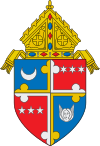St. Thomas Manor
St. Thomas Manor | |
Port Tobacco | |
| Coordinates | 38°27′56″N 77°1′25″W / 38.46556°N 77.02361°W |
|---|---|
| Area | 10.7 acres (4.3 ha) |
| Built | 1741 |
| Architectural style | Georgian |
| NRHP reference No. | 88002050[1] |
| Added to NRHP | November 10, 1988 |
St. Thomas Manor (1741) is a historic home and
Description
The house is a two-story, seven-bay, brick structure of
Connected to the manor house stands a two-story brick wing that incorporates a former chapel built in 1798, now called

A cemetery lies to the west of the manor house and church. Notable parishioners are buried there, including
St. Thomas Manor was listed on the National Register of Historic Places in 1988.[1] Due to its history and scenic waterfront setting, the manor grounds, church and cemetery attract visitors from distant places. They make up a favorite rest-stop for many bicycle tour groups.
Additional significance
In 1794 it was at St. Thomas Manor that
The St. Thomas complex was also the site of the revival of the Jesuit order in the United States in 1805, after it had been suppressed by the Catholic Church in 1773. Three American priests took their vows at St. Ignatius Church.[2]
Some of the slaves owned by the Jesuit Maryland Province resided at St. Thomas Manor. They were among the
Catholic Church and Indian records
During the years of
Gallery
-
St. Thomas Manor, Historic Marker, September 2009
-
St. Thomas Manor, St. Ignatius Church, June 26, 2011.
-
Explanatory sign at St. Thomas Manor, St. Ignatius Church, June 26, 2011.
See also
References
- ^ a b "National Register Information System". National Register of Historic Places. National Park Service. 9 July 2010.
- ^ a b c d e f g J. Richard Rivoire (December 1987). "National Register of Historic Places Registration: St. Thomas Manor" (PDF). Maryland Historical Trust. Retrieved 1 January 2016.
- ^ "Mudd, Sydney Emanuel ", Maryland Biographical Dictionary, pp. 388-389
- ^ "Report of Income &c. of Farms of St. Thomas Manor, 1833, By McSherry · Georgetown Slavery Archive". slaveryarchive.georgetown.edu. Retrieved 2 February 2018.
- ^ ""The sale of two unnecessary negroes": Bishop Carroll to Fr. Neale proposing the sale of slaves, November 12, 1805 · Georgetown Slavery Archive". slaveryarchive.georgetown.edu. November 1805. Retrieved 2 February 2018.
- ^ "Report – Slavery, Memory, and Reconciliation". slavery.georgetown.edu. Retrieved 2 February 2018.
- ^ Helen C. Rountree, Wayne E. Clark, and Kent Mountford, John Smith's Chesapeake Voyages (2007)
- ^ Merrell, James H. "Cultural Continuity Among the Piscataway Indians of Colonial Maryland." William & Mary Quarterly, 3rd series, 36 (1979): 548-70
External links
- St. Thomas Manor, including undated photo, at Maryland Historical Trust
- Society of Jesus, Northeast Province
- Parish Website






